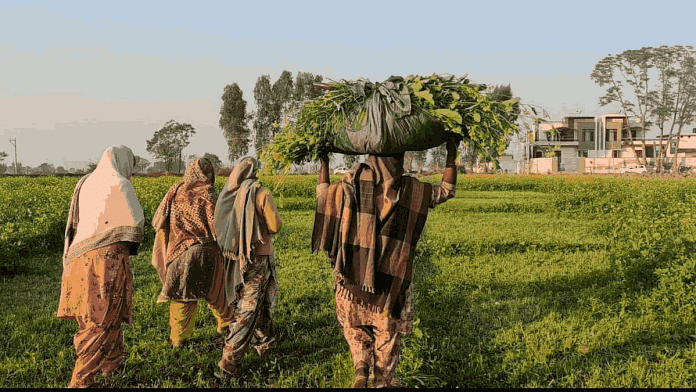New Delhi: As the fallout of climate change threatens to alter farming practices, and hints at the possibility more droughts, fires, and flooding, women in India’s agriculture sector could be among those most impacted, a new study published in the Frontiers in Sustainable Food Systems journal Thursday has found.
The study maps hotspots in “low- and middle-income countries” (LMICs) where climate change, agriculture, and gender inequality intersect. It found that women in the agricultural sector in South Asian countries, such as India, Bangladesh, and Pakistan could be most impacted by the possible fallouts of climate change on the sector.
From having unequal access to wealth and ownership, to being nutritionally deficient, the study presents evidence of women in LMICs as being more vulnerable to harm. It also points out that despite constituting 48 percent of the rural agricultural labour force in low income countries, women are more severely affected by events that impact agriculture such as droughts or floods. In India, for instance, twice the number of women than men reported eating less during a drought, according to the report.
Authored by researchers from the CGIAR Gender Platform, the International Rice Research Institute, the International Food Policy Research Institute, the Accelerating Impacts of CGIAR Climate Research for Africa (AICCRA), and the World Bank Group, the study, ‘Where women in agri-food systems are at highest climate risk: a methodology for mapping climate–agriculture–gender inequality hotspots’, uses the Intergovernmental Panel on Climate Change (IPCC) framework to determine climate change risk. The authors also used publicly available data from LMICs to map regions that face this risk.
An index created by the report categorises countries based on climate change risk faced by women working in agriculture in the country — from highest climate risk to lowest risk.
To determine this ranking, the report uses three factors — climate hazards, exposure to climate hazards, and vulnerability of women owing to existing gender inequalities. India is one of the countries in the highest-risk category, along with others such as Pakistan, Afghanistan, Sudan, and Yemen. In all, the study ranked 87 LMICs across the globe.
“Fostering an enabling environment for gender equality in the face of climate change does not stop with the identification of climate-agriculture-gender inequality hotspots,” said the authors of the study.
Further step may include, “a validation of the locality as a hotspot using secondary case study evidence, analysis of the main contributing components – hazards, exposure, vulnerability – based on the data used for identifying hotspots, in-depth case studies in hotspot localities of the way agri-food system outcomes, climate resilience capacities and gender inequalities intersect, as well as the prevalent policies; and pilot studies testing the potential of interventions or policy to support gender equality in adaptive and resilience capacities and climate action in hotspot localities.”
Also read: India among 10 countries with most infants who missed 1st measles shot — report by WHO & US CDC
Inequality hotspots
Climate change hazards referred to in the study include droughts, floods, climate variability, high temperatures, and reduction in crop-growing seasons. To understand the exposure of women to these hazards, the authors used indicators like female employment in agriculture.
As for the vulnerability of women in agriculture systems in these countries, the study uses the Social Institutions and Gender Index created by the Organisation for Economic Co-operation and Development, which scores countries on a parameter of 0 to 100, based on how discriminatory their laws and social norms are towards women. India has a score of 43 in the index.
By taking the average values of the three indicators, the study created a map that marks the climate-agriculture-gender inequality hotspot countries in the world. According to the study, most of South Asia features in the highest-risk group, as do some countries in Africa. The study explains though, that the reasons for the two regions being hotspots differ — in South Asia, high rates of climate disasters are the reason, while in Africa it is the high vulnerability of women due to structural inequalities.
The study also looks at how some women have fewer capabilities of adapting to climate-resistant agriculture, and explains that in South Asia and Africa, average women farmers do not own as much land or have as much money as do male farmers. This means they are at less of an advantage when climate change hazards strike, says the study.
While gendered experiences of harm and climate change have been discussed before, the study takes it one step further by mapping vulnerability hotspots. Beyond the country level, there are four case studies of two countries each in South Asia and Africa — Pakistan, Bangladesh, Mali, and Zambia — where the authors carried out district-level risk analysis.
“The relevance and urgency of identifying localities where climate change hits agri-food systems hardest and is likely to negatively affect population groups or sectors that are particularly vulnerable is increasingly acknowledged in the literature and, in the spirit of leaving no one behind, in climate and development policy arenas. Hotspot maps can guide the allocation of scarce resources to most-at-risk populations,” said the authors of the study.
(Edited by Smriti Sinha)
Also read: Focus on mitigating urban flooding, other climate issues in 2nd phase of Centre’s scheme for cities



